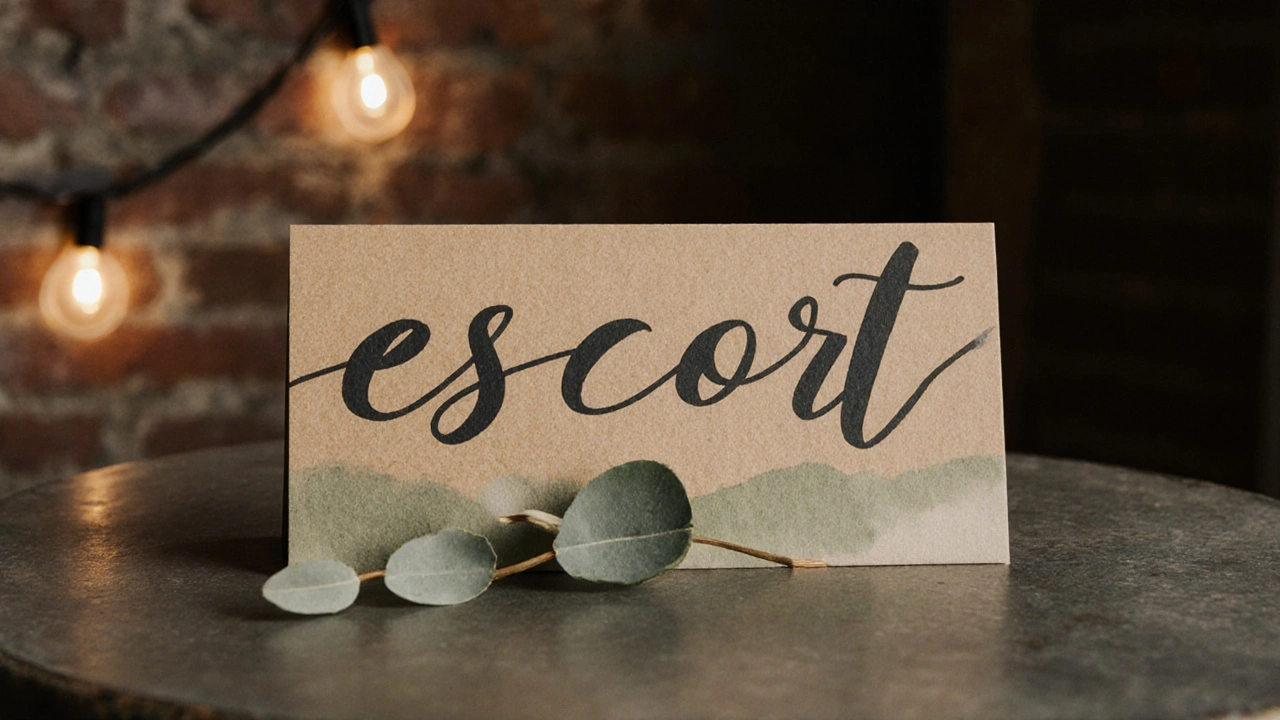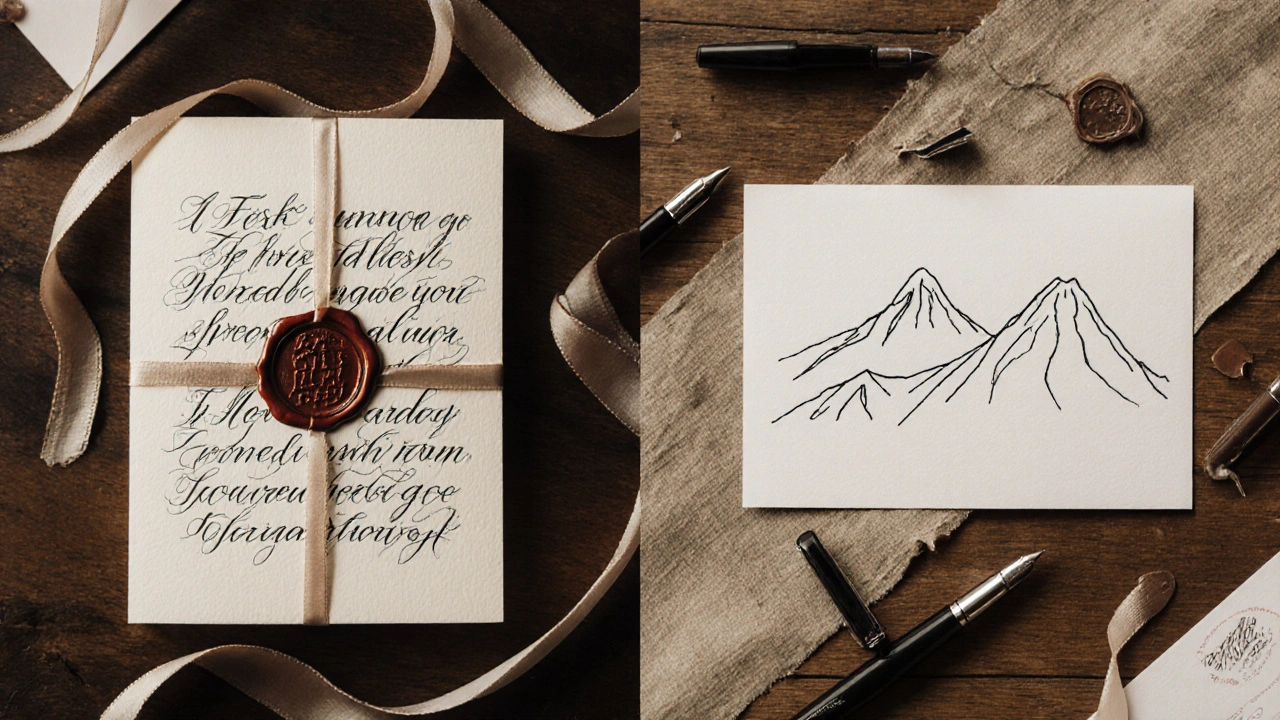Wedding escort cards aren’t just functional-they’re the first impression guests get of your big day. And when it comes to writing names on those tiny cards, the style of calligraphy you choose sets the tone. Will it feel like a vintage letter from a 19th-century aristocrat? Or like a sleek Instagram post printed on matte cardstock? The difference between traditional and modern calligraphy isn’t just aesthetics-it’s emotion, expectation, and memory.
What Makes Traditional Calligraphy Work for Wedding Escort Cards
Traditional calligraphy, often called traditional calligraphy, draws from centuries of handwritten art. Think Copperplate, Spencerian, or English Roundhand. These styles are elegant, flowing, and precise. Each letter has a deliberate thick-thin contrast, created by pressure on a nib pen. The result? A look that screams formality, heritage, and timeless romance.
Many couples choose this style for classic venues-grand ballrooms, historic churches, or garden weddings with wrought iron gates. It pairs naturally with ivory cardstock, gold foil accents, and wax seals. I’ve seen wedding planners in Perth use traditional calligraphy on escort cards with edges trimmed in lace, tucked into vintage envelopes. Guests don’t just read the name-they feel the weight of tradition.
This style isn’t easy to pull off. It requires practice, patience, and the right tools: a dip pen, ink that doesn’t bleed, and paper with enough tooth to hold the ink without smudging. Most professionals spend months mastering it. But if you’re going for that heirloom feel-where your escort cards could one day be framed-it’s worth the effort.
Modern Calligraphy: Where Personality Meets Simplicity
Modern calligraphy broke the rules. It’s looser, bolder, and less rigid. You’ll see slanted letters, uneven baselines, and playful flourishes that look handwritten, not machine-perfect. It often uses brush pens or fine-tip markers like Tombow or Pentel Touch. No dip pens. No ink wells. Just a pen in your hand and a sense of rhythm.
Modern calligraphy thrives in minimalist weddings-industrial lofts, beachside receptions, or urban barns with string lights. It works beautifully on textured paper, recycled kraft, or even small wooden tags. I’ve seen couples use this style for escort cards with their guests’ names in lowercase, paired with a tiny line drawing of a eucalyptus leaf or a mountain silhouette.
The appeal? It feels personal. Like your best friend wrote your name on the card. It’s not about perfection-it’s about presence. And because it’s easier to learn than traditional styles, many DIY brides and grooms pick it up in a weekend. YouTube tutorials, printable worksheets, and affordable brush pens make it accessible. You don’t need to be an artist. You just need to care enough to try.
Traditional vs Modern: A Side-by-Side Comparison
| Feature | Traditional Calligraphy | Modern Calligraphy |
|---|---|---|
| Origin | 17th-19th century European scripts | 20th-21st century, influenced by hand-lettering trends |
| Tools | Dip pen, nib, ink, ruled guides | Brush pen, fineliner, marker |
| Letterform | Uniform, symmetrical, highly structured | Variable, expressive, slightly uneven |
| Thick/Thin Contrast | High, deliberate pressure-based | Moderate, often created by stroke direction |
| Learning Curve | 6-12 months to master | 1-4 weeks to get started |
| Best For | Formal, classic, luxury weddings | Relaxed, rustic, boho, or contemporary weddings |
| Cost (DIY) | $50-$100 for tools and supplies | $20-$40 for beginner kit |

When to Choose One Over the Other
There’s no right answer-only the right fit for your wedding’s vibe. If your invitation suite uses serif fonts, velvet ribbons, and crystal place cards, traditional calligraphy will feel like a natural extension. It doesn’t shout. It whispers elegance.
But if your wedding playlist includes indie folk and your reception table has mismatched china and handwritten menus, modern calligraphy will feel more authentic. It’s the style of someone who values warmth over formality.
Some couples mix both. They use traditional for the parents’ names and modern for the friends’ names. Or they use traditional on the main escort card and modern on the drink menu. That’s fine. But don’t do both styles on the same card unless you’re confident in your skill. Clashing styles can look messy, not creative.
Common Mistakes to Avoid
Even experienced calligraphers slip up. Here’s what goes wrong-and how to fix it:
- Using the wrong paper. Thin cardstock bleeds. Choose 120-160 gsm paper. Test with your pen first.
- Skipping a practice run. Write all names on scrap paper. You’ll catch spacing issues before you ink the real cards.
- Over-flourishing. A little flourish is charming. Too much looks like a spider crawled across the card. Less is more.
- Ignoring legibility. Fancy doesn’t mean unreadable. If your guests have to squint, you’ve lost the point.
- Waiting until the last minute. Calligraphy takes time. Allow 2-3 days per 50 cards if you’re doing it yourself.

What Guests Actually Notice
Most guests won’t know the difference between Copperplate and modern brush script. But they’ll feel something. They’ll notice if the names are neatly aligned. If the ink looks crisp. If the card feels like it was made with care.
I’ve talked to wedding guests after events. One woman said, “I kept my escort card because it looked like it was written by hand for me.” That’s the magic. It’s not about the style-it’s about the intention behind it.
Whether you choose traditional or modern, your escort cards become tiny keepsakes. They’re the first thing guests touch. The last thing they see before heading to their table. Make sure they carry the same warmth your vows do.
Can I use a printer for calligraphy-style escort cards?
Yes-but only if you’re using a high-quality digital font designed to mimic real calligraphy. Avoid generic script fonts like “Script MT” or “Brush Script.” Look for fonts like “Allura,” “Dancing Script,” or “Parisienne.” Even then, printed text lacks the human touch. For the best result, hire a calligrapher or handwrite them yourself.
How many escort cards should I make?
Make one for each guest, plus five extra. Some guests arrive late. Others might misplace their card. And if you’re using a seating chart, you’ll need backups. For a 100-person wedding, print or write 105 cards.
Is modern calligraphy cheaper than traditional?
Yes, for DIY. Brush pens cost under $30, and you can learn the basics quickly. Traditional calligraphy requires more expensive tools-nibs, ink, holders-and takes longer to master. If you’re hiring a professional, prices vary more by experience than style. A skilled calligrapher might charge the same rate whether they use a dip pen or a brush.
Can I mix calligraphy with other design elements?
Absolutely. Modern calligraphy pairs well with watercolor washes, geometric shapes, or minimalist icons. Traditional calligraphy looks best with classic elements like lace, gold foil, or engraved borders. Just keep the overall design balanced. Don’t add more than two visual elements beyond the writing.
Where can I buy quality paper for wedding escort cards?
Look for 120-160 gsm paper from specialty stationery shops. Brands like Canson, Clairefontaine, or Rhodia work well. In Australia, try Paper Source, The Paper Company, or local art supply stores in Perth. Avoid glossy or coated paper-it repels ink and causes smudging.
Next Steps: How to Get Started
If you’re leaning toward traditional calligraphy, start with a beginner’s Copperplate guide. Practice the alphabet for 15 minutes a day. Use a lightbox or tracing paper to copy examples. Don’t rush. It’s a slow art.
If modern calligraphy calls to you, grab a Tombow Dual Brush Pen (F54 or F58 are popular), some 120 gsm paper, and a free worksheet from Pinterest. Write your own name 20 times. Then your partner’s. Then your guests’. You’ll find your rhythm.
Either way, your escort cards will become part of your wedding story. Not because they’re perfect. But because they were made with thought. And that’s what people remember.
